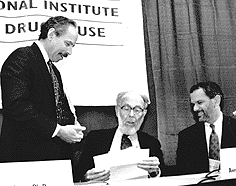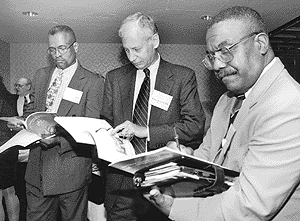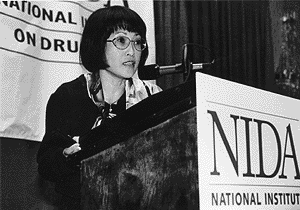In response to an upsurge in heroin use among America's young people in recent years, NIDA convened a national research-based conference on Heroin Use and Addiction in Washington, D.C., this past September. The well-attended conference drew more than 600 participants who examined all aspects of the changing nature of heroin use in the United States and shared scientific information and approaches to preventing and treating heroin abuse and addiction. Representatives of national drug abuse organizations, scientists, prevention and treatment practitioners, and criminal justice personnel took part in the conference.
 At NIDA's heroin conference, NIDA Director Dr. Alan I. Leshner, left, talks with Dr. Avram Goldstein of Stanford University, center, and Dr. Eric Nestler of Yale University School of Medicine.
At NIDA's heroin conference, NIDA Director Dr. Alan I. Leshner, left, talks with Dr. Avram Goldstein of Stanford University, center, and Dr. Eric Nestler of Yale University School of Medicine.In his opening remarks, NIDA Director Dr. Alan I. Leshner cited figures from national drug abuse surveys and surveillance systems that show heroin use increasing during the 1990s, particularly among people ranging in age from 12 to 26. "Today, we are launching a preemptive strike to halt this trend before it can become a crisis," Dr. Leshner said. His call to action was echoed by Health and Human Services Secretary Dr. Donna E. Shalala and by General Barry McCaffrey, director of the White House Office of National Drug Control Policy, in their keynote speeches.
The proliferation of cheap, high-purity heroin during the 1990s has played an important role in the increase in heroin use among young people, a number of researchers reported at the conference. In the early 1980s, the purity of heroin on New York City streets was about 5 percent, according to Dr. Marian Fischman of Columbia University School of Medicine in New York. In 1996, the Drug Enforcement Administration estimated that heroin purity ranged from 68 percent to 80 percent, Dr. Fischman said. High-purity heroin enables users to get high by snorting and smoking the drug instead of injecting it, Dr. Fischman said, noting, "This ability to use heroin without injecting it makes it more attractive and less frightening to the user."
Many young people have a naive belief that because they are snorting or smoking heroin and not injecting it, their heroin use is not addictive, Dr. Leshner said. This is a dangerous misconception, he said. Clinical studies show that "heroin taken by the intranasal route is a potent reinforcer, and physical dependence occurs with repeated use," Dr. Fischman noted. As a heroin user becomes addicted to heroin, tolerance develops and more drug must be taken to achieve the same effect. Thus, there is a real risk that people who snort heroin will progress to injection, which is the fastest and most efficient way to take the drug, Dr. Fischman said.
For heroin users, behavioral, social, and health consequences multiply over time. Data from a long-term study of Vietnam War veterans show that "those who used heroin in Vietnam are at significantly higher risk for other substance abuse, post-traumatic stress disorder, suicidal behaviors, and premature death later in their lives than those who did not use heroin during their tours," said the study's principal investigator, Dr. Rumi Kato Price of Washington University School of Medicine in St. Louis, Missouri. Additional possible health consequences of heroin injection chronicled in other presentations include acute and fatal overdose; bacterial infections including infection of the heart lining and valves; fungal infections; blood-borne viral diseases, particularly HIV/AIDS and hepatitis B and C; and tuberculosis.
 Meeting participants review informational materials on heroin abuse, prevention, and treatment that were distributed throughout the conference.
Meeting participants review informational materials on heroin abuse, prevention, and treatment that were distributed throughout the conference.Heroin Addiction and Treatment
Some of the known neurobiological processes through which heroin use becomes addictive were explained by Dr. Avram Goldstein of Stanford University in Palo Alto, California, and by Dr. Eric Nestler of Yale University School of Medicine in New Haven, Connecticut. With repeated heroin use, extensive changes occur in brain neurons and pathways that are critical to experiencing pleasure and reward, they noted. These alterations in the brain short-circuit the user's ability to experience normal pleasures and create a need for more drugs, explained Dr. Nestler. "These changes play an important role in craving and relapse," he said.
A number of pharmacological and behavioral treatments can address the changes in the brain and behavior that occur with heroin addiction, several researchers noted. "Both methadone and LAAM (levo-alpha-acetyl-methadol) are highly effective medications for treating heroin addiction," Dr. Goldstein said. Though neither medication is a cure, both work to stabilize the brain's reward system, suppress heroin withdrawal symptoms, and relieve craving, enabling patients in treatment to function normally, he said.
One of the pioneering scientists in early methadone treatment studies, Dr. Mary Jeanne Kreek of The Rockefeller University in New York, said that more than 30 years of research have demonstrated that methadone is safe and effective in treating heroin addiction and reducing its harmful consequences. Reductions in injecting drug use and needle sharing along with lower incidence of HIV infection are all associated with being in methadone treatment, noted Dr. Kreek and other researchers. Methadone treatment for heroin-dependent pregnant women also reduces morbidity and mortality among addicted mothers and their newborn infants, said Dr. Karol Kaltenbach of Jefferson Medical College in Philadelphia.
 Dr. Rumi Kato Price of Washington University School of Medicine details some of the harmful consequences of heroin use.
Dr. Rumi Kato Price of Washington University School of Medicine details some of the harmful consequences of heroin use.In addition to medications, behavioral therapies in residential and outpatient settings play an important role in treating heroin addiction, according to a number of presentations. One effective cognitive-behavioral approach cited is long-term treatment in a residential community of counselors and fellow recovering addicts, often referred to as a therapeutic community. Other promising cognitive-behavioral approaches include contingency management, which offers incentives to patients for staying drug free, and relapse prevention strategies that modify patients' thinking and behaviors and increase their coping skills to deal with difficult situations.
Combining such behavioral therapies with pharmacotherapy to meet the needs of individual patients results in the most effective treatment, a number of speakers said. In addition, controlled studies show that adding appropriate psychosocial services, such as employment counseling, psychotherapy, and family therapy, to methadone treatment increases its effectiveness, noted Dr. A. Thomas McLellan of the University of Pennsylvania in Philadelphia.
Several presentations featured programs that can prevent heroin use and addiction. Two family-based programs, the Strengthening Families Program and the Focus on Families Program, have been effective in reducing risks of drug abuse among children at risk of drug abuse. (For more information on these prevention programs, see "Children on the Brink: Youths at Risk of Drug Abuse," NIDA NOTES, May/June 1997)
